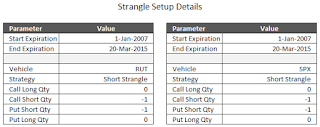Option Strangle Series - Higher Loss Thresholds
During the next several weeks, I will show the backtest results for selling Strangles on the Russell 2000 Index (RUT) and S&P 500 Index (SPX). The prior post, Introduction To Options Strangles, introduced Strangles and compared them with Iron Condors. For this new series, we will look the following setup:
These short Strangles will be entered at six different days-to-expiration (DTE): 45, 52, 59, 66, 73, and 80. For each of these DTE, we will test selling Strangles with short strikes at three different delta: 4, 6, and 8.
The core of this series is related to the exits. The following 8 exits will be tested:
These exits can also be thought of as risk:reward exits. Using the prior example of the Strangle-ExOut (200:50), we are risking 200% to make 50%. These odds don't sound great from a classical stock strategy approach, but the win rate and probabilities of exit are key components of the Strangle strategy's profitability.
If you don't want to miss my new blog posts, follow my blog either by email, RSS feed or by Twitter. All options are free, and are available on the top of the right hand navigation column under the headings "Subscribe To RSS Feed", "Follow By Email", and "Twitter". I follow blogs by RSS using Feedly, but any RSS reader will work.
 |
| (click to enlarge) |
These short Strangles will be entered at six different days-to-expiration (DTE): 45, 52, 59, 66, 73, and 80. For each of these DTE, we will test selling Strangles with short strikes at three different delta: 4, 6, and 8.
The core of this series is related to the exits. The following 8 exits will be tested:
- Strangle (100:50) - exit if the trade has a loss of 100% of its initial credit OR if the trade has a profit of 50% of its initial credit OR at Expiration.
- Strangle (200:50) - exit if the trade has a loss of 200% of its initial credit OR if the trade has a profit of 50% of its initial credit OR at Expiration.
- Strangle (300:50) - exit if the trade has a loss of 300% of its initial credit OR if the trade has a profit of 50% of its initial credit OR at Expiration.
- Strangle (NA:50) - exit if the trade has a profit of 50% of its initial credit OR at Expiration.
- Strangle-ExOut (NA:50) - exit if the moves beyond either short strike OR if the trade has a profit of 50% of its initial credit OR at Expiration.
- Strangle-ExOut (200:50) - exit if the moves beyond either short strike OR if the trade has a loss of 200% of its initial credit OR if the trade has a profit of 50% of its initial credit OR at Expiration.
- Strangle (200:25) - exit if the trade has a loss of 200% of its initial credit OR if the trade has a profit of 25% of its initial credit OR at Expiration.
- Strangle (200:75) - exit if the trade has a loss of 200% of its initial credit OR if the trade has a profit of 75% of its initial credit OR at Expiration.
To clarify how these exits function, let's look at an example of the Strangle-ExOut (200:50) variation. In this example, lets assume the RUT is at 1200, and our strangle short strikes are 1100 for the puts, and 1300 for the calls. If we sell a 1-lot Strangle for $200, we would take our loss when the Strangle had to be bought back at $600. $600 - $200 = $400, or a loss of 200% or our initial credit. For this example, our profit taking would occur when we could buy back the Strangle for $100. $200 - $100 = $100, or 50% or our initial credit. Our other loss exit would occur if the RUT dropped below 1100, or went above 1300. This price movement exit would only trigger if the prior loss related exit had not yet triggered.
These exits can also be thought of as risk:reward exits. Using the prior example of the Strangle-ExOut (200:50), we are risking 200% to make 50%. These odds don't sound great from a classical stock strategy approach, but the win rate and probabilities of exit are key components of the Strangle strategy's profitability.
If you don't want to miss my new blog posts, follow my blog either by email, RSS feed or by Twitter. All options are free, and are available on the top of the right hand navigation column under the headings "Subscribe To RSS Feed", "Follow By Email", and "Twitter". I follow blogs by RSS using Feedly, but any RSS reader will work.